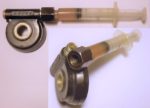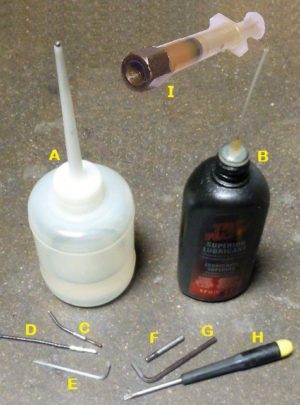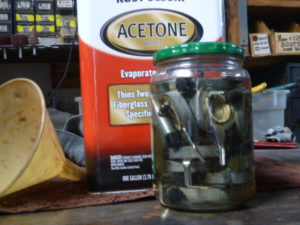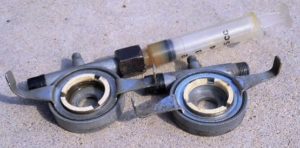Basic troubleshooting: Either the speedometer or odometer can work without the other, but the both need the cable and driver to be working. So if both speed and miles don’t work, it’s usually caused by a broken or slipping cable, and sometimes a broken or slipping driver. If either the speed or miles works, then then both the cable and driver must be good.
Stuck solid (frozen): Old speedometers become frozen where the cable enters. The grease there becomes sticky after many years. That causes the cable to break, or sometimes the driver. That is the main reason why 35 year old mopeds often have broken speedo cables. The other reason is the cable gets kinked. Speedometer drivers also become frozen after many years.
Unfreezing speedometers is done with a modified allen wrench with a tapered square end. It should fit snug in the square cable hole. Heat from a small torch is used to soften the hard tar. Once the square hole can turn a tiny bit, go backward. Go back and forth gradually more and more, adding drops of acetone or penetrating oil as necessary. Once it is free to turn by hand, but still sticky, then a drill is used to spin it faster than by hand, using a modified drill bit with a tapered square end. It can take days or weeks and dozens of repeated applications of penetrating oil and rotation on a drill, before all of the stickiness is gone. If any stickiness is left behind, it can re-freeze a year later.
Unfreezing drivers: See below for the detailed procedure that involves soaking in acetone.
Greasing drivers: Most 70’s metal speedo drivers had a grease zerk, but most 80’s plastic ones did not. One way to grease them without a grease gun or zerk is with spray chain lube. It penetrates in thin and then soon becomes thick. Another way is with a 5cc syringe and a 10-1.00 x 15 tall nut (for a Peugeot moped flywheel).
A. Speedometer Tools
A. Acetone in a drip bottle with thin spout, for dissolving tar. Acetone is a powerful solvent that dissolves ink, tar, and paint. It penetrates into soft materials like rubber and vinyl, causing them to swell, distort, and become weaker. Lacquer thinner and MEK are similar to acetone.
B. Tri Flow drip lubricant, for applying drops of oil. It contains banana oil and microscopic Teflon spheres.
C. 1.7mm cable end bent. This is for counting revolutions when measuring gear ratio on 1.8-hole drivers.
D. 1.9mm cable end straight. This is for spinning 2.0-hole speedos on a drill.
E. Modified allen wrench, ground to a 1.9mm square on the small end. This is for applying torque to a stuck 2.0-hole speedo, and for rotating back and forth once it is able to move, or around and around if it’s able to move in circles.
F. Tapered square end shaft, for spinning 2.7-hole speedos with a drill.
G. Modified allen wrench, ground to a 2.6mm square on the small end. This is for applying torque to a stuck 2.7-hole speedo, and for rotating back and forth once it is able to move, or around and around if it’s able to move in circles.
H. Small screwdriver for rotating 2.7-hole speedos.
I. Greaser made from a 5 cc syringe and a M10-1.0 x 15 hex15 tall-thin nut (for a Peugeot flywheel). It was pure luck that the nut threaded tightly onto the smooth, tapered plastic spout. Of course, this is only for M10-1.0 thread speedo drivers, which fortunately is the majority.
B. Unfreezing Huret speedo drivers
1970’s Huret speedometers and drivers become frozen (stuck solid) after 40 years. Other kinds do also but not as much. Even new speedos and driver become frozen, because the Huret grease decomposes into hard sticky tar. Out of a sample of 30 new and 10 used 70’s Huret speedo drivers, all were frozen solid.
Ten frozen Huret speedo drivers were soaked in acetone in this sealed glass jar. After 17 hours they were removed and tested. 8 out of 10 were able to move, but 2 were still stuck solid. Those 2 were re-soaked with a new batch of frozen ones.
Acetone breaks down hard insoluble tar that is like taffy, and makes it less sticky and more soluble in diesel fuel or gasoline. When first removed from a day of soaking in acetone, the tar would ooze out like warm peanut butter when compressed air was applied to the cable hole. But after 20 minutes, that same peanut butter re-solidified, as the acetone evaporated out of it. So they need to go into the diesel fuel bath right after the acetone bath, rather than drying out first. They also need rotation to spread the solvent to all areas, like stirring.
The 8 unfroze drivers were then soaked in diesel fuel along with 7 others that did not need an acetone bath. The diesel fuel dissolves the loosened tar visible on the outside, as well as some soluble tar on the inside. After 2 days of soaking, 11 out of 15 moved freely, but 4 were still sticky. Those 4 were returned to the acetone bath pickle jar. The rest were brushed, cleaned and then blow dried with compressed air.
While waiting to be greased, 1 of the 11 drivers refroze and 2 became sticky, as acetone evaporated from the grease inside. Those 3 were returned to the pickle jar of acetone.
The remaining 8 clean and free drivers were greased with a modified syringe, made from a 5 cc syringe and a 10-1.00 x 15 tall nut (for a Peugeot moped flywheel). Each driver took 0.2 to 0.6 cc of lithium grease. The syringe has to be squeezed really hard with both hands. The grease goes in slowly. The gears are rotated in between squeezes to spread out the grease. Soon the old black grease and solvent oozes out from the thin gaps, like on the left driver in the above photo. The feel goes from gritty to greasy as the new grease pushes out solvent and grit.
The last step was straitening the fingers as needed, with a needle-nose pliers.
17 stuck drivers became 8 ready to use drivers. For the other 9 the entire process was repeated, as many times as necessary. This is how new and used 1970’s Huret (and others) speedo drivers are refurbished in preparation for sale.



